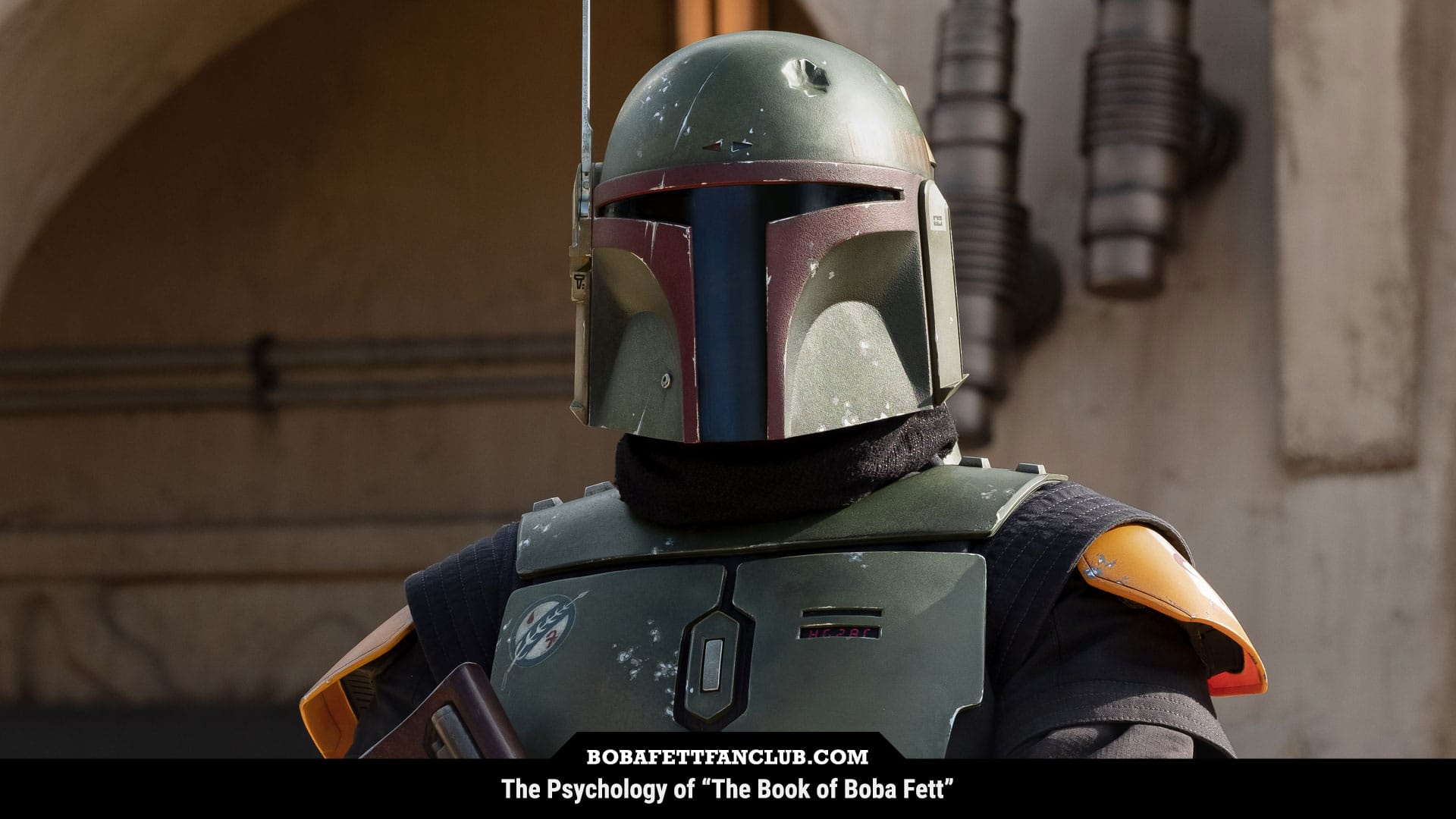
The Psychology of "The Book of Boba Fett"
“The Book of Boba Fett” offers a lot to think about beyond the surface. Fans were divided on it, which is fine; fans should be allowed to protest if they are truly passionate about the Fett and not simply being toxic for the sake of attention. “Speak freely,” as Boba said.
It would be ignorance not to cede that Jon Favreau’s Boba Fett vision is different than that of George Lucas, or the Expanded Universe/Legends that included multiple novels/short stories/comic books, and video game appearances that showed Boba Fett, and also Jango Fett, as star characters with more developed stories and personalities, rather than cool side villain portrayal of George Lucas’ original “Star Wars” trilogy and vintage animations like “The Story of A Faithful Wookiee” and “Droids” that kept him a more mysterious presence. However, falling into the Sarlacc pit nearly ended it for Boba Fett, as that became an obstacle when Disney acquired “Star Wars” from Lucas. His fate was left in question once again in the “Aftermath” trilogy that invented Cobb Vanth, who wore Boba’s armor for some time on Tatooine to protect Freetown, after acquiring the armor from the opportunistic Jawas who stole it near the Sarlacc pit.
It wasn’t until “The Mandalorian” series premiered that fans began thinking there could be a chance that Boba Fett could return, as he did in Legends, as the protagonist (Din Djarin) was, personality-wise, more based off Boba and Jango Fett than he was the Mandalorians of Mandalore/Concordia, yet he was also unique enough to be his own character. It was refreshing to see a Fett-like character, and even better when Fett got teased at in Season 1 Chapter 5 and Season 2 Chapter 9 of “The Mandalorian,” before returning in Chapter 14 in his armor, but it made us wonder what Fett had been doing for the past five or so years, and when “The Book of Boba Fett” showed us the transformation he went through, people were split on the characterization. It creates for a fascinating psychological study on the character. Did Jon Favreau’s vision make sense? Was it misunderstood from a psychological point of view?
Falling into the Sarlacc pit would ultimately re-make him, to a degree, but this isn’t a simple Disney-fied version of Boba Fett. A Disney character is not typically complex. This isn’t the simple case of a bad guy who turned good. Boba Fett was a victim and survivor of War, who survived and thrived as a hunter and did jobs for both the governing Empire and the gangsters outside the law. It is ironic a clone would work for the Empire after they abused and disposed of the clone troopers, but like a young Boba angrily said, he was not like them. Boba Fett would have reason to keep his helmet on all the time during the Age of Empire when you consider what the clones went through; it was a way of disassociating himself from that. After all, he had his own personal tragedies; there was no reason to conflate that with the tragedy of the clones he had no allegiance to.
However, as he stated to Fennec Shand and Krrsantan, he saw many of those he worked for in a negative light (“Don’t work for Scugholes” and “I’m tired of working for idiots who are going to get me killed”). Boba only really trusted himself, and in his career only cared about bounties. He acted professionally but deep down had no respect for the cruel individuals employing him. Boba is also very much the image of his father, the one person he had trusted in his young life, so why wouldn’t he only trust himself? And like Hondo Ohnaka told Boba Fett, Jango Fett was an honorable man.
The only Mandalorian -ish traditions Boba inherited were the armor, a love of weapons (“Weapons are part of my religion” as Din Djarin put it), and bounty hunting. He was never raised in a Mandalorian tribe outside of having a father who had been part of a faction that got killed off in a war involving both Death Watch and the Jedi. Jango trained Boba briefly however as a hunter, and saw potential in his son to carry on his legacy. The armor to Boba represented more of a love for his father than tradition, because that was the only true family he had outside of part-time mentors and hunters he worked with, like his “Krayt’s Claw” group during The Clone Wars. His sister Omega (revealed in “The Bad Batch”) was not known, as she was raised separately, so Boba’s time at his birth home Kamino was fairly solitary, especially when his father left for jobs. “The Book of Boba Fett” shows his past loneliness through flashbacks, with a young Boba leaping out of his bed to watch the Slave I firespray ship take off into the stormy and dark Kamino clouds raging over a surface of violent waves.
“I grew up surrounded by water” is how Boba Fett put it when talking with the water monger of Mos Espa who sought Fett’s help over a matter of stolen water in Chapter 3 of “The Book of Boba Fett.” It’s true, Boba Fett for the most part, grew up surrounded by water. On the surface it’s a simple reference to “Attack of the Clones,” but it also shows the kind of upbringing Boba had. As good a father Jango was he could do little about the loneliness Boba would experience on his own. Sure, he could talk to a Kaminoan, a droid, or watch the clones train, but it was a lonely life on a dark, watery planet with very little to mentally stimulate Boba.
It works that Boba Fett said very little during the events of Original Trilogy films, as he was not raised with many opportunities to be social. While being silent was originally a trait he had been given because it made him an intimidating, stoic presence like the Man with No Name who Clint Eastwood portrayed in film, the flashbacks of “The Book of Boba Fett” show it was more than just about looking cool. Most of Boba Fett’s socialization came after Jango Fett passed when he met associates of his father (Aurra Sing and Bossk), and then within a Republic prison (where he meets Cad Bane whom he knew of from his father), before expanding to exploring the rest of the universe. The Mandalorian Din Djarin was similarly a “Man with No Name” archetype character, but within his actual story you see that Din was living underground with a Mandalorian tribe that practiced old Mandalorian rules, and thus his socialization was completely limited.
Another character whose socialization was limited was Grogu. Much like Boba Fett, Grogu was a victim and survivor of The Clone Wars who did not have a normal social life after. At one point the Nikto gang/syndicate had held Grogu captive where he presumably was locked up in extreme isolation for a long time, until being saved by Din Djarin. Much like Boba Fett and Din Djarin, Grogu similarly suffers from traumatic flashbacks as well. “The Book of Boba Fett” finds a way to connect these three stories. Each character had a dark past, and they were able to overcome it and eventually find family. Grogu found Din Djarin who adopts him, and eventually Din Djarin learns to socialize with Mandalorians that are different from himself, be it Boba Fett who does not identify as one, or Bo-Katan Kryze who once associated with Death Watch and whose sister Satine was the leader of Mandalore, during the New Mandalorian era that rejected the old warrior ways. Grogu himself becomes a Mandalorian as a result of the support he shows his surrogate father. It reminds me of how a young Jango Fett on Concord Dawn found himself becoming Mandalorian by helping Jaster Mereel and his faction. Grogu, Jango Fett, and Din Djarin became Mandalorian Foundlings not just because they suffered through traumatic events and were lucky to get saved by Mandalorians, but it came about through loyalty. Jango was loyal to Jaster and fought with him against many dangers willingly. Grogu has been loyal to Din, and faced many dangers as well, such as the mighty Mudhorn.
Din Djarin, in a more unique case, shows his loyalty through abiding a strict Mandalorian code that he learned from the Armorer, to whom is a teacher to him, and as well Paz Vizsla, a Heavy Infantry Mandalorian. When you feel you owe your life to a cause, you do your best to play by the rules, and the Armorer has many rules. It was fortunate that Boba Fett was not raised this way. Jango Fett’s faction of Mandalorians believed in honorable mercenary work, and encouraged bounty hunting. They did not agree with extremism, be it in the pacifistic way of New Mandalore that exiled warriors for political reasons and looked down on bounty hunting, be it the savage barbarity of Death Watch who gladly backstabbed their own kind, and most likely the ‘True Mandalorians’ did not agree with the outdated ancient methods that the Children of the Watch decided to revive. As tragic as Boba Fett’s beginnings were he was spared the Mandalorian politics and religious customs. Din Djarin’s tribe of the Armorer and Paz Vizsla were problematic for him. “The Way” was above all in the aftermath of the Purge of Mandalore and those who did not walk the way were not just seen as Apostates, they were also seen as cursed.
It was very important for Din Djarin to meet Boba Fett again, even if by chance, when Din Djarin was ex-communicated from his tribe because he admitted to removing his helmet. While this may sound ridiculous to most, the shame and guilt Din felt was overwhelming. He knew he couldn’t just go get Grogu from Luke Skywalker, but he had a need to see him. Visiting his lost son made him only feel worse however, as he could not get close without interfering with his training, and thus getting a job from Fennec Shand and Boba Fett was the very thing Din needed psychologically. He even said he would do it for free, which no doubt was something Boba Fett did not expect. How many jobs did Boba Fett ever do for free as a bounty hunter? Not many, and if he did, it was probably a payback mission — but to Din Djarin, he was returning the favor to Boba Fett who had assisted him in rescuing the child from Moff Gideon. This was loyalty, something key to Mandalorian culture (“Loyalty and solidarity are the way” as said in Season 3 of “The Mandalorian”). Din Djarin needed to feel like a real Mandalorian again, and Boba Fett who saw the Mandalorian traditions as “bantha fodder” suddenly saw why his father Jango had become a Mandalorian — because it was honorable.
And it’s that Mandalorian moment with Boba Fett in the finale that is so crucial to both character’s trajectory. Boba Fett could have given up against his former mentor and rival Cad Bane. Cad Bane was not convinced Boba had changed, referring to him as a cold-blooded killer when negotiating with Cobb Vanth of Freetown. He figured Boba did try to change and become a better person, in a naïve attempt at redemption, but that he was still the cold-blooded person he used to be. “You’re getting soft in your old age”, said Cad Bane, mocking Boba’s attempt to change. When Cad Bane heard his employers at the Pyke Syndicate had killed the Tusken Tribe that Boba Fett had associated with, he was able to connect the dots in his mind. Given Fennec Shand had thought Boba Fett was dead, it’s safe to assume Cad Bane thought the same before hearing Boba Fett killed Bib Fortuna to become Daimyo of the Mos Espa territories. “What’s your angle?” is what Cad Bane wondered when speaking with Fett in the finale of “The Book of Boba Fett.” Indeed, to Cad Bane a bounty hunter retiring to take a piece of Tatooine and make it free of the Spice trade did not make a whole lot of sense. However once he heard there was a Tusken tribe in Boba’s story Cad Bane was able to make the connection that Boba saw the Tuskens as family.
It’s true, Boba Fett was very much family to the Tuskens. To Tusken Kid he was a surrogate father who saved his life. To Female Tusken Warrior, Boba Fett was a great friend with whom she could spar with in gaffi stick combat training, and to the Tusken Chief Boba was a great guide, someone capable of special things, be it slaying a behemoth sand creature, acquiring speeder bikes, finding the wood of a tree in the middle of the dune sea needed to make a gaffi stick, or stopping a long train that carried spice, water, and snipers who would indiscriminately shoot down the native Tuskens, simply for existing on their drug route. Boba valued them equally, feeling that they treated him as an equal, and grateful for being saved from death near the Sarlacc pit despite the abuse he suffered from the young Tuskens hitting him to weaken his strength more. Boba knew not to take that personally though.
Boba Fett knows the difference between right and wrong. He felt bad for the moisture farmer getting beat to death by the Nikto gang of Tatooine for example. He showed sympathy to the animals of Tatooine, especially the Banthas. Sometimes, Boba made the mistake of feeling bad for the wrong people, like the Rodian he offered to free from his bonds only for the Rodian to alert the Tuskens to Boba’s escape attempt. To me the choice of a Rodian was intentional in the story — a reminder of Greedo, the first bounty hunter of “Star Wars,” who didn’t last long, just like the Rodian in “The Book of Boba Fett.”
Boba Fett does have a righteous side, despite his reputation for being “cold blooded”. Even in his past with his experience with Han Solo — catching a smuggler like Han was seen as a righteous thing; he was a smuggler not paying his debts and was also an outlaw, so Han’s screams of pain did not bother Boba one bit on Cloud City. We see righteous anger with Boba Fett and the Nikto gang on “The Book of Boba Fett.” Boba Fett was deceived to think the Nikto were guilty of killing the Tuskens so he took it personally. I think because he already disliked the gang for their violent thieving ways he was quick to assume they were guilty without direct proof. So Boba wiping out the Nikto gang with the Slave I’s weapons was a righteous act of vengeance, albeit unknowingly misdirected. Likewise in the Tosche Station, Boba did not hesitate to brutalize the Nikto gang members, knowing their nature. In doing so he saves two of Luke Skywalker’s past friends, whom Boba ignores. It’s interesting to note his indifference to Camie and Fixer in this situation. Boba Fett does not see himself as a hero.
To go back on the Pyke Syndicate’s act of evil, it may have seemed Boba Fett was foolish to think the Pyke Syndicate would not have resorted to such tactics like eliminating an entire tribe out of greed. Many critics of “The Book of Boba Fett” pointed this out as being uncharacteristic of Boba to be deceived and manipulated easily, however it should be noted that Cad Bane was also surprised by the Pyke’s strategy. “I didn’t realize the Pyke Syndicate were so ruthless?” Indeed, the Pyke Syndicate are ruthless enough, even enough to also bomb “The Sanctuary”.
The Sanctuary in many ways was like a clean, city version of the Cantina of Mos Eisley. It’s the place where people went to gamble, drink, and listen to music played by Max Rebo and others. Generally it’s more of a social club rather than a spot where any real crime took place. The type of place a retired bounty hunter would enjoy… or hate, as in the case with Krrsantan who much prefers fighting. When the hostess of the Sanctuary Garsa Fwip bravely interrupted Krrsantan fighting a group of Trandoshans, who are a species Wookiees dislike, it became clear to Boba Fett who was there, that he could make use of Krrsantan. “Looks like you could use a job?” Boba similarly employed the Modders, a colorful gang of bikers who modify their body parts with the help of Modifiers who operate almost like the tattoo artists of Tatooine, giving the youth a way to modify themselves, but they also serve a medical purpose, being able to modify the disabled and the dying (in the case of Fennec Shand who Boba Fett saved from a gut shot from a blaster). Boba perhaps saw a bit of his young self when dealing with the Modders, as they showed guts and they reminded him of his troubled youth. He recruits them recognizing their need for work opportunity, while also scolding the water monger for his unfair water prices. Once again, Boba is righteous in his assessment of the situation.
When dealing with the Gamorrean Guards that were once loyal to Bib Fortuna, Boba is once again fair. He could have not taken the chance on employing them but Boba Fett, who got a second chance from the Tuskens, has become a firm believer of fairness. How he dealt with Jabba’s cousins as well shows this. He could have rejected the responsibility of taking care of a dangerous creature like the Rancor after being gifted it. But instead he accepts the responsibility and even takes on learning to ride the creature, which the Rancor Keeper states required a lot of discipline, which did not discourage Boba in the slightest. After all, Boba climbed out of the Sarlacc pit with just armor, a flamethrower, his rangerfinder’s flashlight, and little oxygen to work with. He broke through stomach walls and climbing a nightmarish amount of sand only to be greeted by two unforgiving suns before losing consciousness. After that, riding a Rancor into war would be a worthy challenge. And really that is what “The Book of Boba Fett” is about — overcoming the past, learning from it, and looking to the future.
The Rancor itself went from a period of darkness, with its eyes covered, blinded until he saw Boba Fett. When the Rancor lost control it took the presence of another kindred spirit, Grogu, to calm him down (albeit using The Force), because maybe despite his size, Grogu can relate to the Rancor on some level, having had a rough past as well. Likewise, Boba Fett was once a raging spirit, angered by what he saw as an injustice when Mace Windu killed Jango Fett in battle; a friendless hunter who fell on hard times when Han Solo got lucky,
But Boba Fett’s dreams were no longer just flashbacks of pain, now they also included good memories too, sitting by a campfire with a relatable spirit like Fennec Shand, becoming part of a Tribe, making his Gaffi stick, dancing with the tribe, and talking to his loyal Bantha. Maybe this is not the vision of a Boba Fett show that people wanted, and if he were Mr. Action Man all the time a lot of us probably would not complain, but “The Book of Boba Fett” gives us a continuation of his story arc that at least ends on a high note, although leaves much mystery to what his future will be; if Boba helps Din Djarin hunt down Imperial remnants under the leadership of Grand Admiral Thrawn who recently evaded Ahsoka’s attempt to stop him, or if Boba and Fennec have to fight off other Syndicates who see Boba Fett as a threat, …or what if the power of being Daimyo corrupts Boba? What if he becomes much like Jabba the Hutt, quick to the trigger, and fast to put a bounty on whoever does not pay tribute? It will be interesting to see what Boba Fett’s palace looks like after a few years.
The beauty of “The Book of Boba Fett” is that it still keeps the character a little mysterious, which was so signature to the original version of Boba Fett, it just accomplishes it in a very different way. Now the mystery is what he will do next.
More from This Author
 The Fetts and the Droids: Artificial Intelligence in Fett Lore
The Fetts and the Droids: Artificial Intelligence in Fett Lore
 How Jango Fett's Motivation Evolved from George Lucas to "Legends" to Present
How Jango Fett's Motivation Evolved from George Lucas to "Legends" to Present
 How Boba Fett’s Backstory Evolved from George Lucas to “Legends” to Present
How Boba Fett’s Backstory Evolved from George Lucas to “Legends” to Present
 Why "The Book of Boba Fett" Needs a Revision – And a Renewal
Why "The Book of Boba Fett" Needs a Revision – And a Renewal
More in This Category
 Why "The Book of Boba Fett" Needs a Revision – And a Renewal
Why "The Book of Boba Fett" Needs a Revision – And a Renewal
 What Temuera Morrison Actually Said at Fan Expo Chicago 2024
What Temuera Morrison Actually Said at Fan Expo Chicago 2024
 Exclusive Interview with Boba Fett Stuntman Eyad Elbitar
Exclusive Interview with Boba Fett Stuntman Eyad Elbitar
 What It's Like To Be Boba Fett's Makeup Artist
What It's Like To Be Boba Fett's Makeup Artist
 James Mangold Describes His Shelved 2018 Boba Fett Film
James Mangold Describes His Shelved 2018 Boba Fett Film

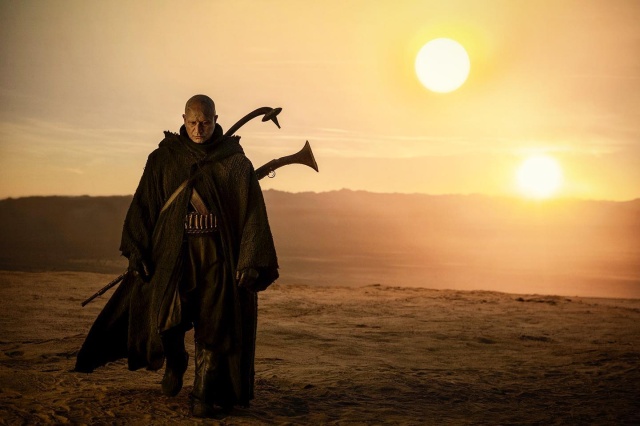
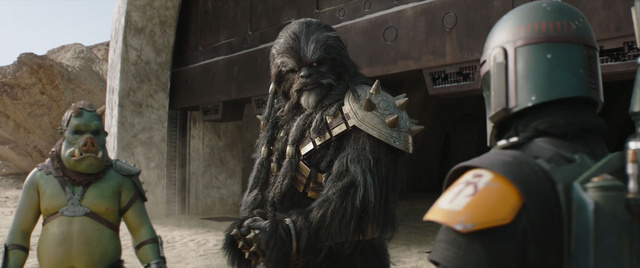
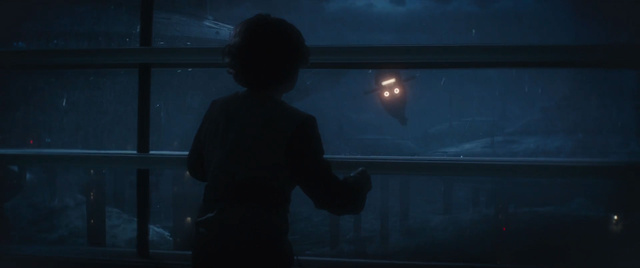
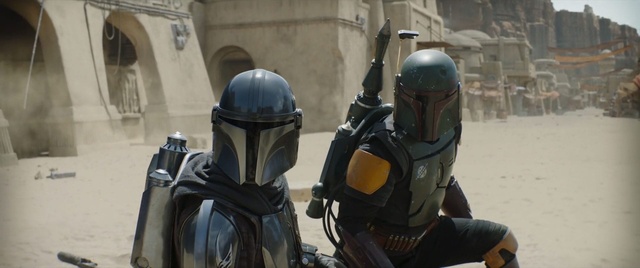
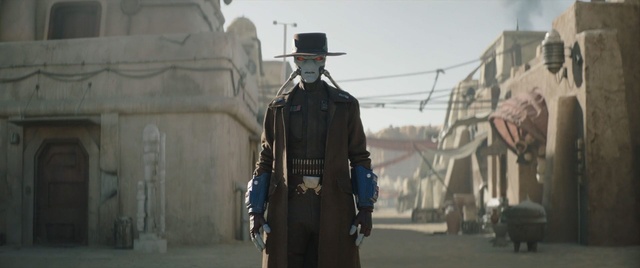
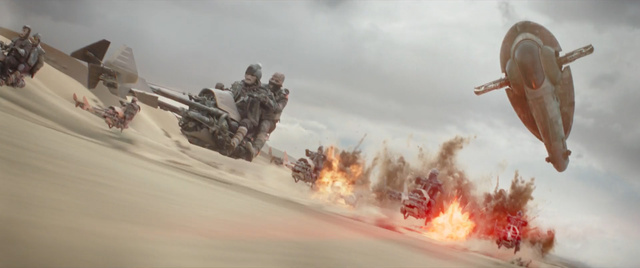
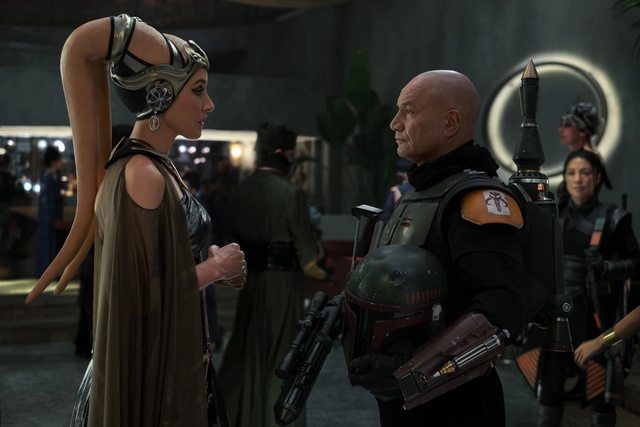
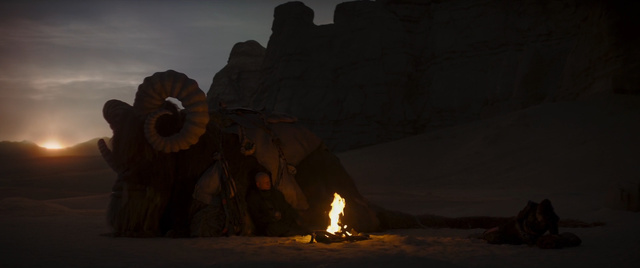


Great read, I enjoyed and agree with your perspective. I would add that Boba has not “gone soft”. He still has the ability to do great damage and destruction. He simply chooses not to, in hopes to take the higher road. I suspect he might find the daimyo gig to be a bit mundane long-term.
Boba recognizes violence is always AN answer, but should never be the FIRST answer. And the choices we make are important. If he chose violence first he might have employees, since he didn’t, he gained friends instead. Friends will have more loyalty than employees, and loyalty is literally the difference between life and death.
This was an excellent read and I agree with the premise. BoBF was a great show and I wish we’d see more of him! I agree with Matt that at the end of the last episode, it was apparent being Daimyo was getting boring for him.
Very good perspective, even helped changed my view on the show!!
Great summary. I’ve been a BOBF apologist since day 1 and have always seen the vision and story in it. I understand the criticisms (some of which I also hold) with the series but there’s still so much greatness in it for me to not love. I’m really hoping there will be a season 2 to explore more of these themes and delve even deeper. (More Boba action too haha)
This was a good read and I agree with most of it but I hate how (physically)weak they made Boba. Why was he not needing Barca treatment earlier in the series ? In the mandalorian he was whooping everyone. I agree there was character development but boba is a cunning tactician and in BOBF he can’t do anything without fennic laying it out for him. Also his intentions are all over the place he does but doesn’t wanna rule and wants to get out of crime but wants to be a crime boss. I like the show but they could have put a little more effort into it, mando is Disneys baby but a lot of us grew up with this character and want the same effort brought to this as to the newer characters.
What an excellent piece, I need to show this to my colleague who thought Boba should have been presented as a “badass”. He genuinely was, but someone who’d grown and matured and had plenty of time to reflect. You’ve put into words what I needed to tell her!